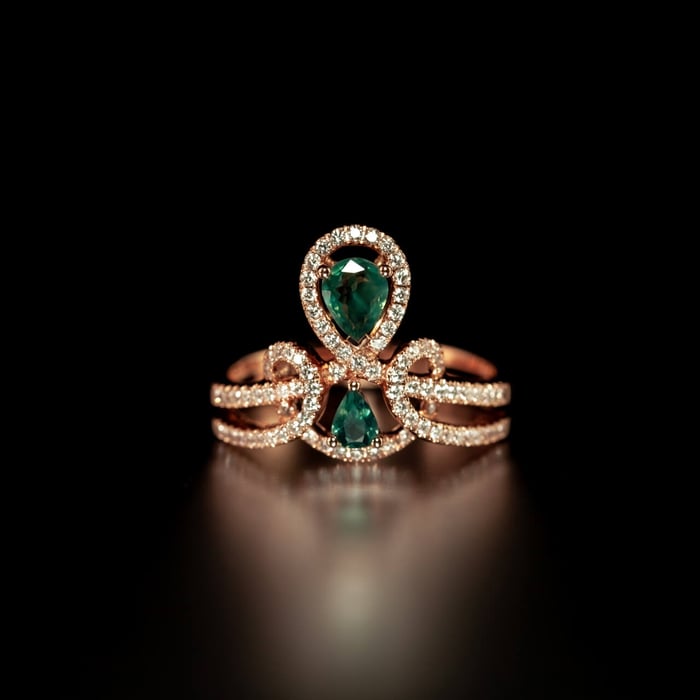How Natural Alexandrite Stone Priced?
To help you understand what factors determine the price of Natural Alexandrite and make an informed decision in selecting the best stone, I have written the following guide for you.
# What Is Alexandrite Worth?
We offer a large selection of GIA Certified Alexandrites in different price ranges. Each Alexandrite's value is defined by 5C: Clarity, Color change, Color, Carat, and Cut.
Gemologists use four criteria, also known as 4C, to evaluate any precious stone. The 4C means Carat, Color, Clarity, and Cut.
With alexandrites, you should add a 5th C, - Color Change. And this is considered to be the most crucial factor defining the value of alexandrites simply because it is a unique quality of this gemstone only.
Each Alexandrite stone is unique. Mother nature does not produce ideal alexandrites displaying perfect 5C except for some miraculous gemstones you can find at Smithsonian Institute. Even there, they are not flawless. Therefore we should judge the value of each stone using the combination of all these factors. Some may be more prominent than others.
It also very much depends on individual taste and preference. Some people pay more attention to the size of the stone, some to color change, some to clarity, and some want the stone to have a perfect cut to be very brilliant.
That is why I spend so much time and effort describing all the nuances of evaluating gemstones. I want to give you all the information to judge the stones, assess them for yourself, and then select the pieces most appealing to your taste.
The price of Alexandrite can vary significantly from $1,000 per carat to over $200,000 per carat, depending on many factors. For example, an Alexandrite of 1 carat plus weight is considerably more expensive. The origin, clarity, and degree of color change will also affect the price. Depending on these factors, the price range of 1 carat Alexandrite stone will be $2,500 per carat to $30,000 per carat.
The degree of the color change and the color saturation are the most important factors defining the price of an alexandrite.
With a limited budget, a buyer may prefer a smaller, cleaner stone with an excellent color change or a larger, more included gemstone with a weaker color change. The price may be the same, but the strength of the color change should be the most crucial criterion.
Contrary to popular belief, most alexandrites do not change color from emerald green to ruby red. In reality, this only very rarely occurs. Most alexandrites seem to show a bluish-green in daylight, switching to a gorgeous purplish red under incandescent light. Good quality alexandrite appears teal, emerald, or blue-green under natural sunlight and changes to purple-red or reddish-purple under incandescent light.
## How Alexandrite Color Affects Value
Not all varieties of chrysoberyl that change color are considered Alexandrites — color change chrysoberyl and Alexandrite are two different varieties of chrysoberyl. To be accepted as Alexandrite, the gemstone must display a noticeable color shift that has to change to specific colors.
When viewed in daylight and moved to incandescent light, Alexandrite will change color in the following manner: from blue-green to orange-red, from slightly blue-green to red, from green to purple-red, from slightly green to purple-red, or from yellow-green to red-purple.
The most prized, extremely rare Alexandrites are red to purplish-red in incandescent light and green to bluish-green in daylight.
Stones that change color in combinations other than those listed above can be pretty dramatic and may sell for high prices. However, they will not be identified as Alexandrite when sent to a reputed gemological laboratory.
Good quality color change chrysoberyl might sell for $2,500-$4,500 per carat for 1-2 carat stones. On the other hand, genuine Alexandrite of the same size and quality will cost $6,500 per carat. Highly saturated, clean Alexandrite with an intense color change might cost as much as $70,000 per carat.
The stone will be identified as a color-change chrysoberyl if other color-change combinations differ from the classic colors described above. Many gem-quality chrysoberyl stones come from South America, Madagascar, and Sri Lanka. The color change in these stones typically changes from green to yellow, brownish red to purple, or yellow-green to blue-green. These are not classic Alexandrite colors.
Chrysoberyl has a very recognizable light green color, whereas the real Natural Alexandrite is classic bluish green. It never shows a light green hue due to the presence of chromium responsible for the color change phenomenon.
Every Alexandrite is graded according to a Hue, Tone, & Saturation rating for Daylight/Fluorescent lighting and Candlelight/Incandescent lighting conditions. Using the Hue, Tone, & Saturation corresponds to "Exceptional," "Very Good," "Good," "Fair," or "Acceptable."
## Imortant factors to consider when buying Alexandrite
These non-classic color changes may be dramatic but such stones are not necessarily identified as an alexandrite. Although these stones may be declared as Alexandrite and offered for very high prices, they will not be graded as Alexandrite when sent to a reputed gemological laboratory.
The most prized Alexandrite is red to purplish-red in artificial light and green to bluish-green in daylight. The intensity of the primary hue, also known as color saturation, ranges from strong to moderately strong in the most valuable alexandrites. Stones with lower color intensities and those lacking in brightness do not match the quality of the finest Alexandrite and are accordingly lower in price.
Russian Alexandrite remains in extremely short supply, but it exhibits the most exemplary intensity of color and is the standard other Alexandrites are judged. Alexandrite mining in Sri Lanka has produced some larger gemstones, but they tend to be of less desirable colors.
Compared to Russian stones, the reds of Sri Lankan alexandrite tend to be more brownish-red than the finer purplish-red. The greens tend to be yellowish rather than the blue-green of their Russian counterparts. Alexandrite from Brazil sometimes rivals the color of Russian gems. Still, it is also in extremely short supply and quite highly prized.
The best Alexandrites, in terms of quality and price, come from India.
## How Alexandrite Clarity Affects the Value.
Due to its crystal structure and geologic mechanisms, Alexandrite tends to have many inclusions or visible imperfections. Clean stones with good color change and intense colors are extremely rare and will always command premium prices.
Occasionally, specific inclusions are oriented parallel to each other in Alexandrite and lead to a visual phenomenon known as chatoyancy or a cat's eye effect. The stone's value can rise dramatically when these thin, needle-like inclusions are present.
## How Alexandrite Cut Affects Value
Cutting Alexandrite presents a particular challenge to the stonecutter. Because of its pleochroism, the cut of Alexandrite is crucial to its overall look. To take full advantage of the color-change nature of the rough stone, Alexandrite must be cut to show the most potent color change through the crown. The gem cutter needs to orient the rough stone to highlight both colors when viewed in its face-up position.
Alexandrite is usually fashioned with step-cut pavilions and brilliant-cut crowns in what are known as "mixed cuts." The brilliant-cut crowns feature triangular, kite-shaped facets. The pavilions are generally cut with parallel facets in concentric rows.
The cut will always affect the value of a gemstone. Cut refers to an Alexandrite stone's cutting style, proportions, and finish. Because of Alexandrite's rarity, almost all stones found will be cut for maximum weight retention. Well-cut stones are the exception rather than the rule.
Alexandrite is a Type II (GIA Clarity Grading System) stone, and even the best Alexandrite is expected to contain inclusions. Graders employ a system of five clarity grades ranging from eye clean down to severely included to classify clarity in transparent-colored gemstones. The eye-clean grade consists of the top-clarity qualities of gems that commonly appear on the market.
Colored stone graders do not use diamond grades to describe colored stones. Colored stones are rarely as clean as diamonds and should not be graded using the same criteria. Although some specimens meet the standards of flawless clarity established for diamonds, the top qualities of most colored stones include gems with at least some inclusions. Blemishes are confined to the surface and are not considered a part of clarity grading. Colored stones are clarity graded without magnification.
## How Alexandrite Carat Weight Affects the Price
As with most all precious stones, larger alexandrites are more valuable than small ones. While most alexandrites are relatively small, weighing less than one carat, larger sizes command premium high prices.
Even small high-end Alexandrites weighing over .25ct. are very rare. Alexandrites weighing less than .50 carats in the jewelry store can be worth many thousand dollars. Stones over one carat may retail for $15,000/ct. Larger Alexandrites between 2.00 and 5.00 carats can easily be priced over $25,000/ct. Finally, Fine large alexandrites above five or six carats are extremely rare, and top stones can sell for over $200,000.
## Overall Quality
By evaluating all the criteria mentioned above, Alexandrite stones can be categorized into three different price categories:
1. ### Low Grade
Lower quality Alexandrite are highly included and displays very weak color change. These gemstones are budget-friendly and usually cost less than $2000 per carat.
Try to avoid sellers who dramatically overprice such alexandrites. Do not be misled by exorbitant prices. Buyers expect that every Alexandrite is expensive. However, the savvy buyer will evaluate the actual value of the Alexandrite based on all the criteria described in this article.
2. ### Medium Grade.
Medium Quality Alexandrites will display a color change above 50-60%. The Green color of such stones might be less saturated, and the "bleeding" of one color to another is often observed. These stones typically have few inclusions easily seen by the unaided eye, but they are fully transparent.
Alexandrites of this grade are challenging to find due to their high demand. The prices are more affordable than top-quality Alexandrites. Usually, prices for Alexandrites of this grade will be from $7,000 to $20,000 per carat.
Daylight color is essential as well. It would be best to select Alexandrites that have Green to Bluish-Green colors.
As mentioned before, clarity plays a less important role than color change for medium-quality alexandrites. For higher clarity stones, one can expect the price to go up. Such Alexandrites belong to the next category below.
3. ### Top Quality
Top Quality Alexandrites display intense color change (80 to 100%). The origin can seriously increase the price of multifold. For Alexandrites of Brazil and Russian Origins, one can expect a significant premium price doubling the cost of Alexandrites from other origins. The price for a 1-carat top-quality Alexandrite starts from $20,000 per carat.
## Why Our Prices Are so Low?
We offer the lowest prices worldwide because we buy stones directly from the mines, cut them ourselves, and make our jewelry ourselves. Therefore by buying from us, you cut out all intermediaries, each adding to the price like gem dealers, cutters, jewelry manufacturers, wholesalers, and other intermediaries.
Typically gem dealer buys from mines and sells rough stones to the cutter. Then cutter sells polished stones to the wholesale gem dealer, who then sells the gems to the jewelry manufacturer, who sells the jewelry to a jewelry store.
Each of them adds his profit margin to the final price before the piece reaches the jewelry store. And then the store adds its own. That is why many well-established jewelry stores always order natural alexandrite jewelry directly from us. They buy from us and sell it three times higher. I recently saw our ring, which we sold to the LA store for $2200, sold to a walk-in buyer for $6700 in the same store.
Also, our prices are below wholesale because our business is online. We don't have to pay expensive store rent, staff salaries, health insurance, state taxes, etc. We pass all these savings to our clients.



